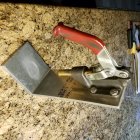CarlGeorge
Silver $$ Contributor
Is there a place one might find these products?You are exactly right. Measuring CBTO does not always allow consistent seating. It's where the seater stem contacts the bullet and where the bullet contacts the rifling, which is very often not where typical ogive tools measure.
A fellow LR BR shooter, who also shoots SR BR, has developed several tools that many top competitors use.
He makes a comparator that measures the bullet where the seater stem contacts it (seater ogive or SO), and another comparator that measures where the bullet contacts the chamber (chamber ogive or CO). These two places on the bullet are not usually where a typical ogive tool contacts the bullet. He also make a comparator for a caliper that matches the seater stem (SO) tool.
When bullets are sorted by SO and CO, they all seat the same and all have the same distance from the chamber.















